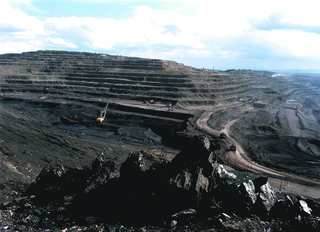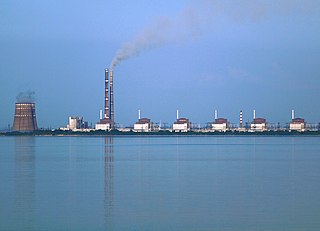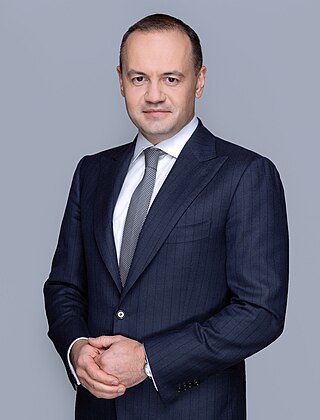Related Research Articles

India is the third largest producer of electricity in the world. During the fiscal year (FY) 2022–23, the total electricity generation in the country was 1,844 TWh, of which 1,618 TWh was generated by utilities.

Energy in Bulgaria is among the most important sectors of the national economy and encompasses energy and electricity production, consumption and transportation in Bulgaria. The national energy policy is implemented by the National Assembly and the Government of Bulgaria, conducted by the Ministry of Energy and regulated by the Energy and Water Regulatory Commission. The completely state-owned company Bulgarian Energy Holding owns subsidiaries operating in different energy sectors, including electricity: Kozloduy Nuclear Power Plant, Maritsa Iztok 2 Thermal Power Plant, NEK EAD and Elektroenergien sistemen operator (ESO); natural gas: Bulgargaz and Bulgartransgaz; coal mining: Maritsa Iztok Mines. In Bulgaria, energy prices for households are state-controlled, while commercial electricity prices are determined by the market.
The energy policy of India is to increase the locally produced energy in India and reduce energy poverty, with more focus on developing alternative sources of energy, particularly nuclear, solar and wind energy. Net energy import dependency was 40.9% in 2021-22.

Joint Stock Company Inter RAO UES, traded as, is a diversified energy holding company headquartered in Moscow, Russia. Its business includes power and heat generation, electricity supply, international energy trading, engineering, design and development of electric power infrastructure. In addition to its assets in Russia it controls several energy companies outside Russia including thermal and hydro power plants, grid operators and energy traders. It holds a monopoly on the export and import of electricity in Russia.

Zaporizhzhia thermal power station is a large thermal power plant (DRES) in the purpose-built city of Enerhodar in Ukraine. It is the most powerful thermal power station in Ukraine, with an installed capacity of 2,850 MWe. Its primary fuel is coal. It can also fire natural gas and fuel oil, and has tank storage for these reserve fuels adjacent to the coal bunkers.

Energy in Armenia is mostly from natural gas. Armenia has no proven reserves of oil or natural gas and currently imports most of its gas from Russia. The Iran-Armenia Natural Gas Pipeline has the capacity to equal imports from Russia.

Ukraine operates four nuclear power plants with 15 reactors located in Volhynia and South Ukraine. The total installed nuclear power capacity is over 13 GWe, ranking 7th in the world in 2020. Energoatom, a Ukrainian state enterprise, operates all four active nuclear power stations in Ukraine. In 2019, nuclear power supplied over 20% of Ukraine's energy.

Coal mining has historically been an important industry in Ukraine. Coal mining in Ukraine is often associated with coal-rich Donets basin. However this is not the only coal mining region, other being Lviv-Volhynian basin and Dnieper brown coal mining basin. The Donets basin located in the eastern Ukraine is the most developed and much bigger coal mining region in the country.
Ukraine has been estimated to possess natural gas reserves of over 670 billions cubic meters (in 2022), and in 2018 was ranked 26th among countries with proved reserves of natural gas. Its total gas reserves have been estimated at 1.870 trillion cubic meters. In 2021, Ukraine produced 19.8 billion cubic meters (bcm or Gm3) of natural gas. To satisfy domestic demand of 27.3 bcm that year, Ukraine relied on gas imports (2.6 bcm) and withdrawal from underground storage (4.9 bcm). Winter demand can reach 150 mcm per day. To meet domestic demand, Ukraine plans to increase domestic natural gas output to 27 bcm.

The Ministry of Energy is the main body in the system of central government of Ukraine responsible for realization of electric power-generating state policies; nuclear-industrial, and oil-gas complexes often referred simply as the Fuel-Energy Complex.

DTEK is the largest private investor in the energy industry in Ukraine. The company's enterprises generate electricity at solar, wind and thermal power plants; extract coal and natural gas, trade energy products in the Ukrainian and foreign markets, distribute and supply electricity to consumers, and develop a grid of supercharger stations for e-vehicles.

Coal supplied over a tenth of energy in Russia in 2022. The prominence of coal power in Russia has been declining since 1990, although Russia has among the largest coal reserves in the world. Russia is the fifth largest consumer of coal in the world and is the sixth largest producer of coal. It is also the world's third largest coal exporter, vying with Australia and Indonesia for markets. It causes pollution in Russia and climate change.

Russia is the fourth largest generator and consumer of electricity in the world. Its 440 power stations have a combined installed generation capacity of 220 GW.

Energy in Ukraine is mainly from gas and coal, followed by nuclear and oil. The coal industry has been disrupted by conflict. Most gas and oil is imported, but since 2015 energy policy has prioritised diversifying energy supply.

Energy consumption per person in Turkey is similar to the world average, and over 85 per cent is from fossil fuels. From 1990 to 2017 annual primary energy supply tripled, but then remained constant to 2019. In 2019, Turkey's primary energy supply included around 30 per cent oil, 30 per cent coal, and 25 per cent gas. These fossil fuels contribute to Turkey's air pollution and its above average greenhouse gas emissions. Turkey mines its own lignite but imports three-quarters of its energy, including half the coal and almost all the oil and gas it requires, and its energy policy prioritises reducing imports.

Solar power in Ukraine is obtained from photovoltaics or solar thermal energy.

Maxim Timchenko is chief executive officer of DTEK. He has headed the company since its foundation in 2005.

Burisma Holdings Limited was a holding company based in Kyiv, Ukraine, for a group of energy exploration and production companies. It was registered in Limassol, Cyprus, until being dissolved in 2023. Burisma Holdings operated in the Ukrainian natural gas market since 2002. It was one of the largest private natural gas producers in Ukraine, circa 2019. It was owned by Ukrainian oligarch Mykola Zlochevsky through his company Brociti Investments Limited.

Coal supplies a quarter of Turkey's primary energy. The heavily subsidised coal industry generates over a third of the country's electricity and emits a third of Turkey's greenhouse gases.

Viktoriya Oleksandrivna Hryb, or Viсtoria Gryb, is a Ukrainian politician, who is serving as a Member of the Verkhovna Rada. She is a Head of the Subcommittee on Energy Security of the Verkhovna Rada Committee on Energy and Housing and Communal Services. Victoria Gryb has over 25 years of professional experience including more than 20 years of experience within roles that combine strategic and managerial responsibility. She has more than 16 years of experience with the Regional USAID Mission for Ukraine, Moldova, Belarus in Kyiv.
References
- 1 2 "Resolution on approval of the Procedure for formation of the forecasted wholesale market price of electricity".
- ↑ "Law of Ukraine on the electricity market".
- ↑ "Rotterdam Plus: Where has the investigation gone?". New Eastern Europe - A bimonthly news magazine dedicated to Central and Eastern European affairs. 9 April 2018. Retrieved 22 October 2020.
- ↑ OCCRP. "Ukraine's Illegal coal mines: dirty, dangerous, deadly". www.occrp.org. Retrieved 22 October 2020.
- ↑ "Из 93 шахт на Донбассе работают всего 24". www.unian.net (in Russian). Retrieved 22 October 2020.
- ↑ "Ukraine cuts coal production by 38.8% in 2015". Interfax-Ukraine. Retrieved 22 October 2020.
- ↑ "Ukrainian private companies intend to import 4 mln tonnes of coal from Russia by late 2014 – Prodan". Interfax-Ukraine. Retrieved 22 October 2020.
- ↑ "Державна служба статистики України". www.ukrstat.gov.ua. Retrieved 22 October 2020.
- ↑ "Report on the results of comprehensive research of electricity and thermal coal markets".
- 1 2 "Дмитро Вовк: раніше всі були фахівцями з політики і футболу, а останнім часом — з RAB-тарифів". Економічна правда (in Ukrainian). Retrieved 22 October 2020.
- ↑ "Формула "Роттердам плюс" була обґрунтована для українського ринку вугілля, - EURACOAL". economics.segodnya.ua (in Ukrainian). Retrieved 22 October 2020.
- ↑ "Война против ДТЭК, звонок Коломойского и дорогой зеленый тариф. Интервью с Андреем Герусом". LIGA (in Russian). 13 October 2020. Retrieved 22 October 2020.
- ↑ "What's Wrong With the 'Rotterdam Formula'?". Ukrayinska Pravda. Retrieved 22 October 2020.
- ↑ "Головна сторінка · Асоціація споживачів енергетики та комунальних послуг". Асоціація споживачів енергетики та комунальних послуг (in Russian). Retrieved 22 October 2020.
- ↑ "SAPO closed the Rotterdam case +". dtek.com. Retrieved 22 October 2020.
- ↑ "Rotterdam". nabu.gov.ua. Retrieved 22 October 2020.
- ↑ "НАБУ провело обыски в НКРЭКУ". Интерфакс-Украина (in Russian). Retrieved 22 October 2020.
- ↑ "Международные и украинские государственные экспертизы подтвердили обоснованность "Роттердам+" — адвокат". glavcom.ua (in Russian). Retrieved 22 October 2020.
- ↑ "SAPO's decision to close Rotterdam + case confirms legality of this principle – DTEK". Interfax-Ukraine. Retrieved 22 October 2020.
- ↑ ""Даже не вдавалась в суть". Венедиктова оставила закрытым дело "Роттердам+" – Слово и дело". LIGA (in Russian). 15 October 2020. Retrieved 22 October 2020.
- ↑ "Введение формулы "Роттердам+" сравняло цену украинского угля с импортным". economics.segodnya.ua (in Russian). Retrieved 22 October 2020.
- ↑ ""Роттердам+" був кращим варіантом для визначення прогнозної ОРЦ, - Рогозін". РБК-Украина (in Russian). Retrieved 22 October 2020.
- ↑ "Offering Circular" (PDF).
- ↑ "AMCU closes Rotterdam + case without establishing violations". Interfax-Ukraine. Retrieved 22 December 2020.
- ↑ Kitsoft. "Антимонопольний комітет України - АМКУ завершив справу за ознаками порушення НКРЕКП законодавства про захист економічної конкуренції". amcu.gov.ua (in Ukrainian). Retrieved 22 December 2020.
- ↑ "Prosecutor closes high-profile Rotterdam+ investigation, again - Jan. 21, 2021". www.kyivpost.com. 21 January 2021. Retrieved 24 January 2021.
- 1 2 3 (in Ukrainian) The same prosecutor closed the case of "Rotterdam +" - NABU for the third time, Ukrayinska Pravda (10 April 2021)
- ↑ "Венедиктова сменила прокурора, который трижды закрывал "Роттердам +"". Украинская правда (in Russian). Retrieved 21 May 2021.
- ↑ "Новый прокурор САП четвертый раз закрыл дело "Роттердам +"". Экономическая правда (in Russian). Retrieved 21 May 2021.